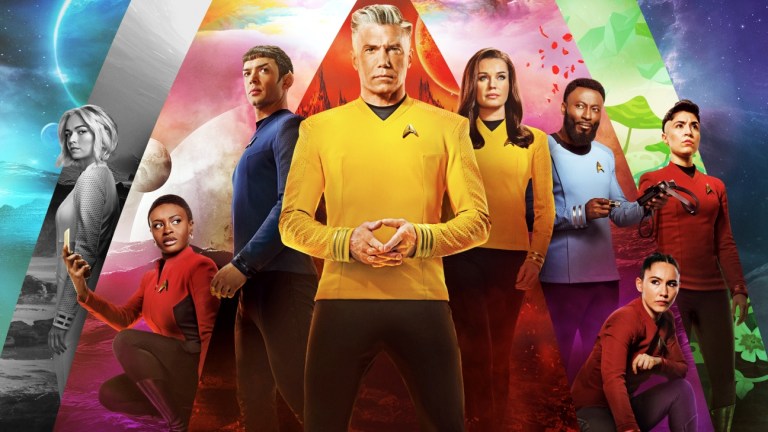Strange New Worlds Finally Corrects One of Star Trek’s Biggest Mistakes
For all its talk about overcoming racism and embracing diversity, Star Trek has sometimes fallen into harmful tropes, including when it comes to the character of Khan.

This Star Trek: Strange New Worlds article contains spoilers.
At the end of the latest episode of Star Trek: Strange New Worlds, La’an Noonien-Singh makes a shocking discovery. Hurled back to 21st-century Toronto, alongside James T. Kirk (Paul Wesley), to stop a history-changing attack by Romulans, La’an finds the holding area of her infamous ancestor, the genocidal warlord Khan Noonien Singh.
Tempted by the opportunity to not only destroy a vicious warlord but to also shake off the hatred for her name that still exists in her reality, La’an enters the room, gun drawn. However, she finds not the glowering madman played by Ricardo Montalbán in Star Trek II: The Wrath of Khan nor the simmering terror played by Benedict Cumberbatch. Instead, she finds a small child, whom she immediately comforts.
As sweet as this moment is, even more notable is who is playing Khan in the scene. It’s talented young actor Desmond Sivan (FUBAR), who is of both Latino and South Asian descent, meaning Star Trek has finally cast a performer of South Asian heritage to play Khan, who is Indian in canon. This is a big deal, especially when you consider the franchise’s blunder when it cast Cumberbatch, a white actor, to play the villain in 2013’s Star Trek Into Darkness, leading some fans to accuse the movie of whitewashing Khan.
It boggles the mind that it’s taken this long to see such an iconic Star Trek character correctly represented by an actor of similar background. After all, Khan was identified as “a Sikh from the northern region of India” in his very first appearance in The Original Series episode “Space Seed” in 1967.
There’s no question that it was the great Montalbán who immortalized Khan as an all-timer of a villain both on the big and small screen, but it’s also true that he was born in Mexico from white European parents. When viewed from a modern lens, this casting is problematic, but it’s important to note that Montalbán was in his own time a revolutionary actor, breaking into Hollywood at a time when there were very few Hispanic performers dominating American screens. His casting in Star Trek as a character of color on a popular TV series would have still felt progressive at the time.
But then Star Trek Into Darkness doubled down on casting a European actor to play the character when Cumberbatch’s terrorist John Harrison reveals that he is actually Khan. To be fair, the Khan twist in the divisive movie, which takes place in an alternate Trek timeline, has more to do with winking at the audience than anything that made sense within the film’s reality. It’s also true that director J.J. Abrams originally cast Puerto Rican actor Benicio Del Toro, but given its opportunity to bring in a performer that could better reflect the character’s background, why didn’t Into Darkness consider a South Asian actor for the role from the start? Perhaps Abrams wanted to wink at an earlier version of the character that didn’t make it into “Space Seed.”
Behind the scenes, Khan wasn’t always Khan. In earlier versions of the “Space Seed” script, writer Carey Wilber imagined the character as a Nordic man called “Harald Ericsson.” Later versions had the character operating under the pseudonym “John Erickson” before revealing himself to be the tyrant Ragnar Thorwald, a conceit that eventually returned in Star Trek Into Darkness. At some point, the character was renamed Khan Noonien Singh, perhaps during the rewrite by the episode’s other credited writer Gene L. Coon, but more likely at the behest of Star Trek creator Gene Roddenberry. Roddenberry served in World War II alongside a man named Kim Noonien Singh, and hoped that the episode would get his attention, leading to a reunion between the old friends.
Interestingly, the Khan we meet in Strange New Worlds exists in an alternate timeline too, one where he’s still a child during the 2020s, not a conqueror during the 1990s. It’s unclear how much the show will use Khan going forward beyond this cameo, despite the season’s clear interest in the Eugenics Wars. But even if this is all just meant to be another wink at fans, the character’s return in this way is Star Trek setting a new, better course, stepping away from Into Darkness‘ mistake and getting that much closer to creating the future it has always imagined.
Star Trek: Strange New Worlds season 2 is streaming now on Paramount+.
